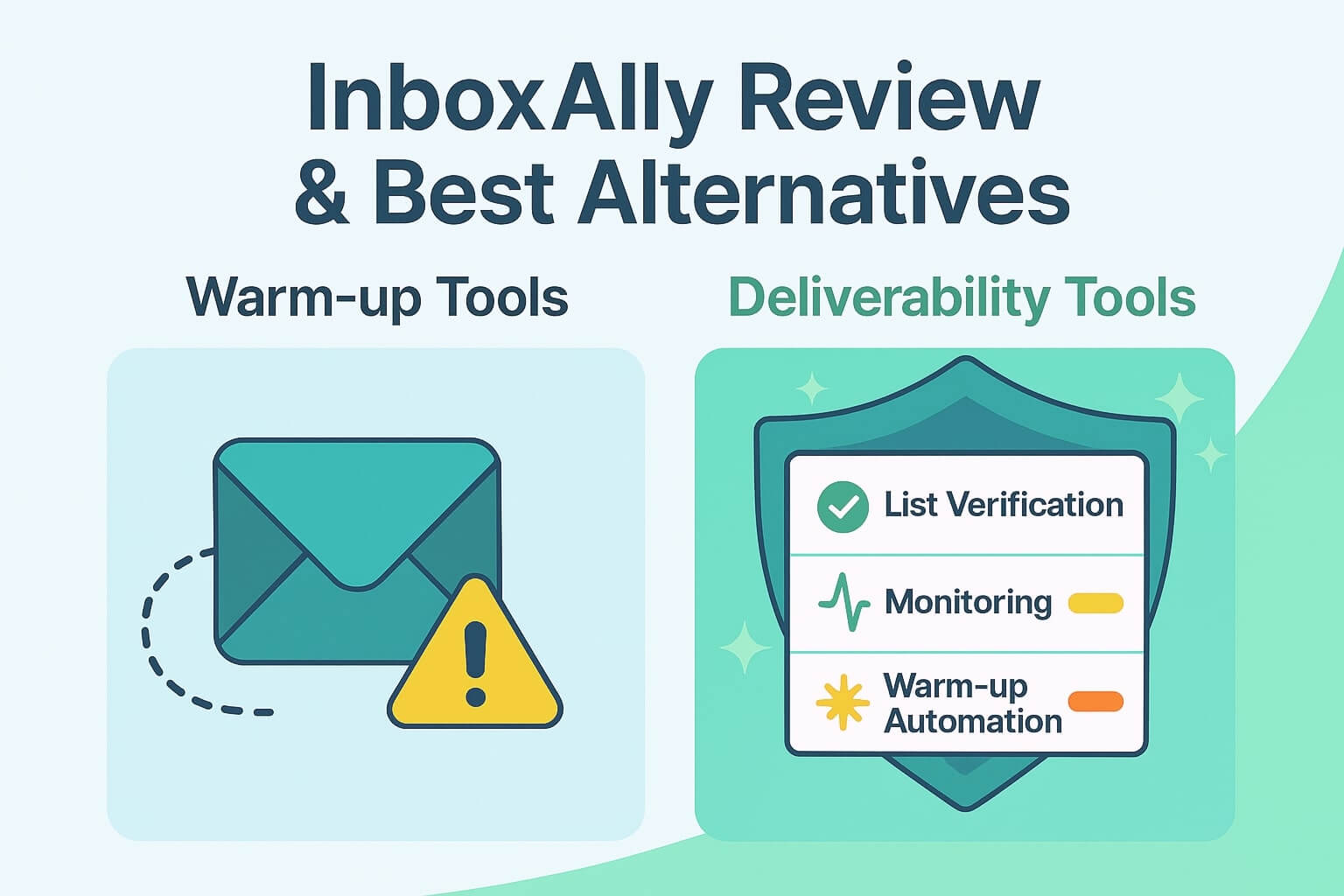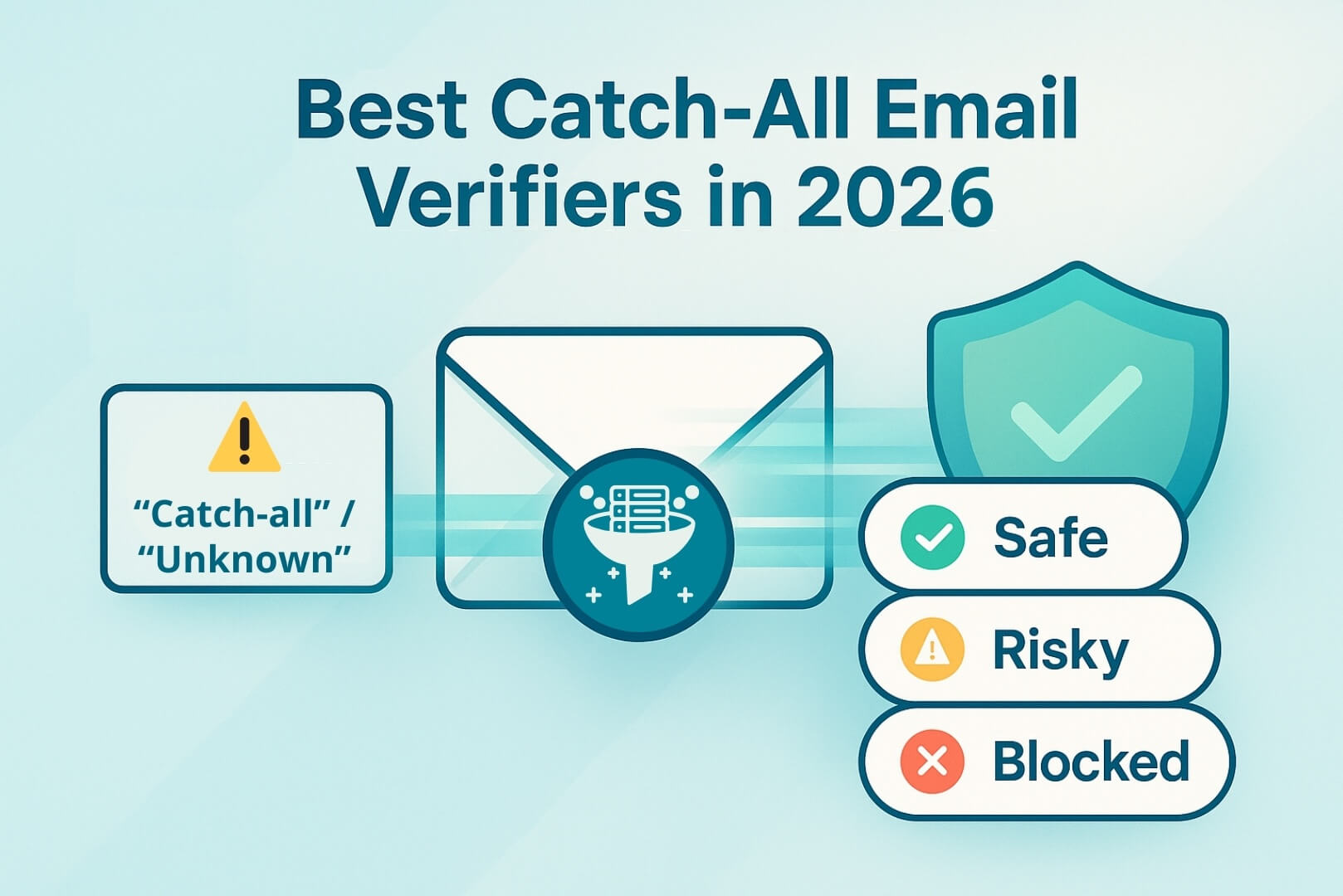For teams evaluating tools to improve inbox placement, InboxAlly is one of the most talked-about names in the warm-up and seed-testing space. This guide delivers an unbiased review of its pricing, features, real-user feedback, and where it fits in the broader deliverability stack.
You’ll also learn where warm-up platforms stop helping, and where list verification and pre-send risk filtering (such as Allegrow’s suite) become the decisive factor for B2B outbound success.
TL;DR: InboxAlly boosts inbox placement by simulating positive engagement, but it only solves one piece of the deliverability puzzle. It doesn’t run verification to detect spam traps, complainers, or risky catch-alls - and it can’t block unsafe sends inside your outreach tools. For teams relying on outbound email, pairing visibility tools with full-stack verification platform is essential to prevent reputation damage and keep deliverability stable.
What is InboxAlly and what problems does it claim to solve?
InboxAlly positions itself as a deliverability enhancement platform that helps senders improve inbox placement and reputation by simulating authentic engagement behaviors. Its tool set targets common pain points for marketers and sales teams, such as emails landing in spam or promotions tabs, poor domain or IP reputation, and lack of visibility into inbox placement.
InboxAlly’s core modules include:
- Warm-up automation: sends and engages with messages to build positive reputation signals.
- Inbox/placement testing: shows where emails land (primary, promotions, spam, or other) across various providers.
- Domain and account audits: reports on configuration issues, blocklists, and technical gaps.
The platform promises to improve inbox placement and reputation over time. While many reviews cite measurable improvement, they also flag pricing jumps and setup complexity as consistent trade-offs.
How seed-list inbox placement works?
Seed testing works by sending emails to a controlled list of test inboxes, or “seeds”, across providers like Gmail, Outlook, Yahoo, and regional platforms. Each inbox then reports whether the message landed in the primary inbox, promotions tab, or spam folder. While this method provides visibility into placement patterns, it has limitations: seed lists rarely reflect your actual audience mix, providers continuously adjust filtering models which can cause results to drift, and snapshot data can lag by several hours.
To use seed testing effectively, treat results as trend indicators rather than absolute truth. A diverse and rotating seed sample offers a clearer picture of whether changes to authentication, content, or sending behavior are improving inbox placement. Over time, consistency across multiple sends is far more informative than any single report.
Warm-up automations and reputation signals
InboxAlly’s warm-up engine creates controlled sending and engagement patterns, that is, emails sent between a network of real or simulated mailboxes that open, star, and sometimes reply. This activity trains mailbox providers to view your domain as trustworthy.
However, no tool can guarantee inboxing. Over-automation or unrealistic engagement velocity can backfire, flagging your account as “behaviorally unusual”.
The best practice is to combine moderate warm-up activity with strong list hygiene, verified contacts, and correct authentication (SPF, DKIM, DMARC). That combination improves reputation organically, not artificially.
InboxAlly Top Features Breakdown
Email Warm-up
The core engine of the platform is designed to "teach" mailbox providers to trust you by simulating genuine interest. It goes beyond simple opens; the system automates high-value positive signals like marking emails as "Important”, scrolling through content to simulate read time, and clicking links.
Most critically for commercial teams recovering from a block, it performs "Spam Rescue”. This feature automatically finds your warm-up emails in the Spam or Promotions folder and moves them to the Primary Inbox. This signals to the algorithm that your mail was misclassified, gradually retraining the filter to prioritize your domain over time.
Placement Testing
Building reputation is blind without visibility, so InboxAlly pairs its warm-up with seed-based reporting. This allows you to see exactly where your emails are landing across major providers (Gmail, Outlook, Yahoo) before you send to your full list.
A standout capability here is their campaign monitoring workflow. You can include their seed addresses in your actual newsletter or sales campaign sends. The system then reports where those specific emails landed across providers, giving you a realistic 'in-the-wild' snapshot of your campaign's performance, rather than just a pre-send estimate.
Email Audit
Think of this feature as your pre-flight diagnostic check. Before you launch, the Email Audit scans your specific email creative—subject lines and body copy—against known spam filters.
It looks for "trigger words" (like aggressive sales language) and checks for broken links or structural issues that might flag you as a low-quality sender. Simultaneously, it runs a technical check to ensure your SPF, DKIM, and DMARC records are visible and aligned. This ensures you don't waste a high-reputation domain on a message that is destined for spam due to a simple content or configuration error.
Domain Report
For agencies managing multiple clients or RevOps leads overseeing several workspaces, the Domain Report acts as a central health dashboard. Rather than getting lost in individual campaign stats, this view aggregates high-level deliverability trends and reputation indicators into a single timeline.
This module is designed to help you spot "silent" infrastructure issues that don't always show up in open rates. It can highlight sudden drops in DMARC compliance or flags on your sending IP, allowing you to proactively switch sending pools or pause campaigns before a small technical dip becomes a domain-wide block.
InboxAlly Pricing and Plans
InboxAlly doesn’t always offer a complete public pricing list, but plans typically scale by the number of sender profiles and daily seed volume.
Common structure:
- Starter tier: around $149/month for a single sender profile
- Plus & Premium tiers: $645–$1,190/month for multiple senders and higher volumes
- Enterprise tier: custom pricing for agencies and large teams
Users note that the price per additional sender profile rises quickly, and feature access, such as priority support or extended reporting, may be reserved only for higher plans.
What to check before you buy
Before committing, review these factors:
- How many sender profiles you need (each mailbox counts).
- Daily test volume limits — this is critical if you run many sequences.
- Support SLAs and onboarding assistance.
- Integration options with your current stack.
- Report exportability for compliance or analytics.
Additionally, although InboxAlly offers a 10-day free trial, this short window can make it difficult to evaluate long-term performance. According to Microsoft's deliverability documentation, achieving maximum deliverability and establishing a positive reputation typically takes 4 to 8 weeks of consistent warming.
A 10-day trial is often enough to get a surface-level feel for the interface, but it is statistically insufficient to judge the lasting deliverability impact on your domain.
Pros and cons from real InboxAlly reviews
Reviews from The Digital Merchant show consistent patterns: users praise InboxAlly’s control and visibility, but frequently cite cost, setup complexity, and limited integrations as drawbacks. Here is a brief overview of recurring pros and cons across sources:
Pros
- Detailed warm-up customization (volume, frequency, engagement type).
- Clear inbox placement visibility across providers.
- Domain and authentication reports that highlight technical misconfigurations.
- Measurable reputation improvement for new or recovering domains.
Cons
- Costs increase steeply per additional sender profile.
- Setup and report interpretation can be complex for non-technical users.
- Limited native integrations with CRMs or sales engagement platforms.
- Results vary depending on data quality and sending behavior, as warm-up alone can’t fix poor lists or content.
Where it tends to work best
InboxAlly tends to work best for new domains building an initial reputation, or for teams recovering from deliverability issues or blocklist events. It’s also useful for marketing or lifecycle teams that need to verify inbox placement before large campaigns.
However, it’s less effective for outbound sales teams trying to use warm-up as a fix for deeper problems like poor data quality, spam-trap exposure, or policy violations. In those cases, tools that provide advanced risk filtering and pre-send enforcement are far more effective at preventing long-term reputation damage and increasing reply rates.
InboxAlly vs Alternatives (and where Allegrow fits)
In today’s deliverability stack, tools generally fall into two categories. Warm-up and placement testing platforms (like InboxAlly, Warmy, or TrulyInbox) focus on simulating engagement and measuring where your emails land across providers. They help visualize inbox placement trends and maintain domain reputation through consistent, low-risk sending patterns.
Risk filtering and monitoring platforms, on the other hand, work further upstream. Instead of reacting to deliverability drops, they prevent them by identifying spam traps, manual reporters, and risky catch-all contacts before a message ever goes out. This is where Allegrow stands out.
For outbound B2B teams, Allegrow adds the protection layer most warm-up tools lack. Besides running a similar automated warm-up process, it also delivers actionable catch-all statuses with clear “valid” or “invalid” outcomes, continuously checks SPF, DKIM, and DMARC configurations, and applies its Safety Net rules to block risky sends in real time. Combined with ongoing inbox placement monitoring, this approach helps teams avoid bounces, complaints, and domain reputation loss before issues escalate.
In short, standalone warm-up tools only address one part of deliverability. Allegrow replaces the need for them by combining warm-up activity with verification, risk filtering, and enforcement, giving you full protection across every factor that affects inbox placement.
Comparison snapshot: features vs outcomes
Conclusion
InboxAlly is a capable tool for teams that need better visibility and simulated engagement. For marketers or domain administrators looking to boost reputation signals, it provides a helpful layer of support. However, relying on simulation alone leaves a dangerous gap in your strategy.
You cannot "warm up" your way out of a bad list. If you are hitting spam traps or inactive mailboxes, no amount of simulated engagement will protect your domain from the resulting penalties. Furthermore, as we discussed, repairing reputation via warm-up is a slow process that can take 4 to 8 weeks to show results. Most B2B revenue teams simply cannot afford to wait two months to fix a deliverability problem.
You need a way to stop the damage immediately, not weeks from now.
That is why we invite you to start a 14-day free trial of Allegrow today. While reputation takes time to build, risk detection is instant. With our free trial, you can scan up to 1,000 of your contacts right now and uncover the spam traps, manual complainers, and dead mailboxes that are silently dragging down your placement. Don’t wait weeks to see if warm-up works; identify your hidden risks today and block them before you launch your next campaign.
Start your 14-Day Free Trial Here
Frequently Asked Questions about InboxAlly
Does InboxAlly guarantee primary inbox placement?
No. No tool can guarantee inboxing. Placement depends on your domain reputation, data quality, content, and ongoing policy compliance.
How much does InboxAlly cost, and what scales the price?
Plans range roughly from $149/month to $1,190/month, depending on sender profiles and daily seed volume. Enterprise tiers are custom-priced for larger teams.
How long until I see results from warm-up?
Most users report visible improvements after 3 to 4 weeks. Measure trends across multiple providers rather than relying on one snapshot report.
Do I still need verification and risk filtering if I use a warm-up tool?
Yes. Warm-up tools only simulate engagement and gradually increase sending volume, but they do not detect spam traps, complainers, risky catch-all contacts, or other hidden deliverability hazards. To truly protect your sender reputation and ensure every email reaches a real recipient, you still need a verification and risk-filtering platform like Allegrow, which covers the full lifecycle of safe email sending (something warm-up alone cannot achieve).





